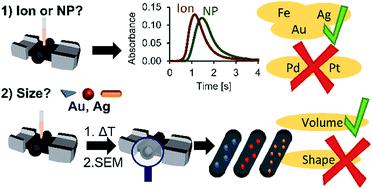当前位置:
X-MOL 学术
›
J. Anal. At. Spectrom.
›
论文详情
Our official English website, www.x-mol.net, welcomes your
feedback! (Note: you will need to create a separate account there.)
Characterization of various metal nanoparticles by graphite furnace atomic absorption spectrometry: possibilities and limitations with regard to size and shape
Journal of Analytical Atomic Spectrometry ( IF 3.1 ) Pub Date : 2020-08-06 , DOI: 10.1039/d0ja00279h Anja Brandt 1, 2, 3, 4 , Karin Kees 1, 2, 3, 4 , Kerstin Leopold 1, 2, 3, 4
Journal of Analytical Atomic Spectrometry ( IF 3.1 ) Pub Date : 2020-08-06 , DOI: 10.1039/d0ja00279h Anja Brandt 1, 2, 3, 4 , Karin Kees 1, 2, 3, 4 , Kerstin Leopold 1, 2, 3, 4
Affiliation

|
Graphite furnace atomic absorption spectrometry (GFAAS) is a promising technique for metal nanoparticle (NP) size characterization and differentiation from ions. However, so far only spherical gold (Au) and silver (Ag) NPs have been investigated. Therefore, in this work, non-spherical Au and Ag NPs, like rods and prisms, as well as other metal nanoparticles, like palladium (Pd), platinum (Pt) and zero-valent iron nanoparticles (nZVI) were examined. In the same way as previously shown for Au and Ag, nZVI can be distinguished from ionic Fe(III) due to a significant shift of absorbance signals to later times, i.e. by evaluation of the recently introduced parameter ‘atomization delay’ (tad). However, both iron species show the same behaviour regarding increasing iron concentration: tad is constant while the appearance time (tAP) decreases. Furthermore, rod-shaped Au NPs and Ag nanoplates can be distinguished from the ionic form. A form discrimination, however, is not possible, since rods and plates are converted to spheres during the temperature program prior to atomization in the graphite furnace tube. The determined diameters of these in situ formed spheres are in good agreement with theoretical ones and diameters determined by scanning electron measurements (SEM). Hence, instead of one-dimensional parameters like width or length, volumes of the initial, non-spherical NPs can be determined by GFAAS. For Pd and Pt neither a differentiation between ions and NPs is possible nor a size discrimination of NPs.
中文翻译:

石墨炉原子吸收光谱法表征各种金属纳米粒子:关于尺寸和形状的可能性和局限性
石墨炉原子吸收光谱法(GFAAS)是用于金属纳米粒子(NP)尺寸表征和与离子区分的有前途的技术。但是,到目前为止,仅研究了球形金(Au)和银(Ag)NP。因此,在这项工作中,检查了非球形Au和Ag NP,例如棒和棱柱,以及其他金属纳米颗粒,例如钯(Pd),铂(Pt)和零价铁纳米颗粒(nZVI)。在如前所示用于Au和Ag以同样的方式,可以的nZVI从离子的Fe(可以区分III)由于吸光度信号以稍后的时间,的显著移位即由最近推出的参数“雾化延迟”的评价(吨广告)。但是,两种铁种类在增加铁浓度方面都表现出相同的行为:t ad恒定,而出现时间(t AP)减少。此外,棒状金纳米颗粒和银纳米板可以区别于离子形式。然而,形状辨别是不可能的,因为在石墨炉管中雾化之前的温度程序中,棒和板会转变成球体。这些原位的确定直径形成的球体与理论球体非常吻合,并且直径通过扫描电子测量(SEM)确定。因此,可以通过GFAAS确定初始的非球形NP的体积,而不是一维参数(例如宽度或长度)。对于Pd和Pt,无法区分离子和NP,也不可能区分NP。
更新日期:2020-08-06
中文翻译:

石墨炉原子吸收光谱法表征各种金属纳米粒子:关于尺寸和形状的可能性和局限性
石墨炉原子吸收光谱法(GFAAS)是用于金属纳米粒子(NP)尺寸表征和与离子区分的有前途的技术。但是,到目前为止,仅研究了球形金(Au)和银(Ag)NP。因此,在这项工作中,检查了非球形Au和Ag NP,例如棒和棱柱,以及其他金属纳米颗粒,例如钯(Pd),铂(Pt)和零价铁纳米颗粒(nZVI)。在如前所示用于Au和Ag以同样的方式,可以的nZVI从离子的Fe(可以区分III)由于吸光度信号以稍后的时间,的显著移位即由最近推出的参数“雾化延迟”的评价(吨广告)。但是,两种铁种类在增加铁浓度方面都表现出相同的行为:t ad恒定,而出现时间(t AP)减少。此外,棒状金纳米颗粒和银纳米板可以区别于离子形式。然而,形状辨别是不可能的,因为在石墨炉管中雾化之前的温度程序中,棒和板会转变成球体。这些原位的确定直径形成的球体与理论球体非常吻合,并且直径通过扫描电子测量(SEM)确定。因此,可以通过GFAAS确定初始的非球形NP的体积,而不是一维参数(例如宽度或长度)。对于Pd和Pt,无法区分离子和NP,也不可能区分NP。











































 京公网安备 11010802027423号
京公网安备 11010802027423号